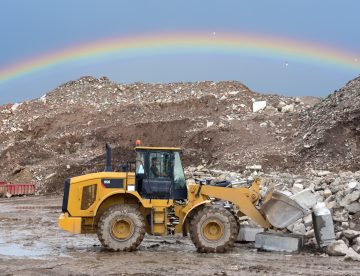
The roar and clatter of bulldozers and excavators have been a long-running soundtrack to construction sites across the world but it seems like something a bit quieter might be on the horizon here in the UK.
The UK government recently published a ‘call for evidence’ on decarbonising non-road mobile machinery (NRMM), which includes construction equipment, hinting at a potential shift away from the diesel-powered giants towards cleaner alternatives. Read this week’s blog to find out more.

At the opening of COP28 this afternoon, the UN Climate Change Executive Secretary, Simon Stiell, gave a powerful speech, urging delegates to accelerate climate action. His stark message was: “If we do not signal the terminal decline of the fossil fuel era as we know it, we welcome our own terminal decline. And we choose to pay with people’s lives”.
With building operations and construction accounting for nearly 40% of global energy-related CO2 emissions, our industry clearly has to be part of that call to action. Read this week’s blog for what one industry expert says are the key points that the sector should be thinking about.

Globally, in every town and every city, concrete is used to give our buildings shape and strength. But the huge scale of the concrete industry comes at a cost – it’s estimated that around 7% of the world’s carbon dioxide emissions come from the manufacture and use of cement, which is the main component of concrete.
Now, a team from the University of Tokyo have come up with a new kind of concrete that has the potential to reduce emissions from the construction industry! Read on to find out more about this concrete of the future.

A year has now passed since the UK went into its first lockdown and, as well as this being such a tragic time for so many people, it’s also been a period when the government has poured an unprecedented £340bn into schemes intended to support companies and individuals through the crisis. Amidst all that COVID-related spending, it can be easy to forget that the country has several other priorities – not least of which is the urgency around climate change. Kicking off what is being dubbed the ‘green industrial revolution’, the government recently unveiled a £1bn funding pot for projects across England that will help to cut emissions from public buildings, schools and hospitals.

When it comes to living, breathing and working within the context of an environmental crisis, it appears the human response is a bit like a game of tug-of-war with various opinions and decisions pulling in opposite directions. On the one hand we have an increasingly urgent need to reduce emissions and halt the disastrous effects…

In the UK, buildings account for around 40% of energy consumption and offices are especially known as enormous energy guzzlers. So, if there was a way for offices and other buildings like classrooms, for instance, to become energy-positive (generating more energy than they consume), this could be a game-changer for the built environment. Such innovation…
